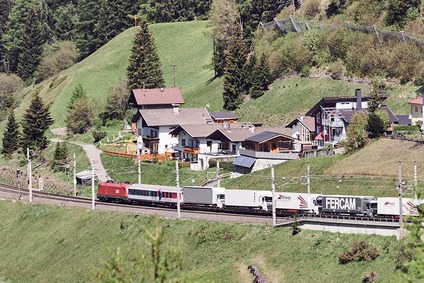
The Rolling Highway (ROLA) is a part of this plan. By 2021, the capacities of currently 200,000 trucks can be increased to around 450,000 trucks per year.
At the traffic summit in Berlin at the end of July, the participants adopted a 10-point plan to relieve the population of heavy commercial traffic along the Brenner corridor. The positive outcome of the talks was is also expressly welcomed by ÖBB. Currently, in the Tyrolean federal state capital, high-level talks are being held about at official level on the implementation of the 10-point plan. The Rolling Highway (ROLAa) has for years been an attractive and effective instrument for the reduction of the traffic burden of the Tyrolean population and is also available as an important solution in the current transit problem via the Brenner Pass. In the 10-point plan, the Rolling Highway is included under point nine "Increase in Rolling Highway capacity between Wörgl and Trento and others". Currently, 18 trains per day are offered per direction on the Wörgl - Brennersee axis and three trains per direction on the Wörgl - Trento axis. With the start of the first run-up phase on January 1, 2020, 21 trains per direction on the Wörgl - Brennersee axis or three trains per direction on the Wörgl - Trento axis will be available daily. At the end of the expansion phase, as of 1 January 2021 there will be 24 trains per day per direction on the Wörgl - Brennersee axis and ten trains per direction on the Wörgl - Trento axis.
"New" - from 1 January 2020 there will be a daily train service on the Regensburg - Trento axis and return; from 1 April 2020, the offer will be extended to four daily trains per direction Regensburg - Trento. At the end of the expansion phase as of 1 January 2021, five trains per day will be available in each direction at the Regensburg - Trento axis.
Increase in capacities (truck) in figures
| Current (2018/19) | as of 01.01.2021 | |
|---|---|---|
| Wörgl – Brenner axis | 648 / day 186,624 / year |
864 / day 248,832 / year |
| axis Wörgl – Trento | 126 / day 36,228 / year |
460 / day 132,480 / year |
| axle Regensburg – Trento | - - |
230 / day 66,240 / year |
| Total capacities (trucks): | 206,000 / year | 447,552 / year |
More than 1,300 fewer trucks on Tyrol's roads every day
All in all, this means that in the final configuration, there will be one ROLA train per hour and direction on the Brenner axle, which contributes to relieving truck traffic on the road. At full capacity on the ROLA, this would mean more than 1,300 lorries per day on Tyrol's roads. As far as rolling stock is concerned, ÖBB's Rail Cargo Group already has 58% quieter wagons in its Austrian freight car fleet and will have converted more than 90% of its Austrian fleet to quiet brake pads by the end of 2021. The other railways are also quickly equipping their rolling stock. In addition, ÖBB does a lot to prevent or at least minimise noise. Over the past ten years, an average of 16 million euros have been invested annually in noise protection measures.
Throughout Austria, 970 km of noise protection walls and dams have been built along the ÖBB lines. In the province of Tyrol, around 80 kilometres of noise barriers and dams have been built. "The capacities are there. The railways are ready," says ÖBB CEO Andreas Matthä. Implementation of the 10-point plan. "The ROLA is already offering an environmentally friendly transport option for more than 200,000 trucks per year. These capacities can be extended until 2021 to around 450,000 trucks," Matthä continued.
Günther Platter, Governor of Tyrol, also welcomes this positive development: "ÖBB is an important partner for Tyrol in many aspects. ÖBB plays a very important role when it comes to relocation, because without a good, functioning offer for the economy we will not come any closer to the goal of relocation. It is therefore very gratifying that ÖBB has put together an offer within a very short period of time, which creates opportunities for short-term relocation via the ROLA. It is important to me that, in addition to building an ultra-modern, future-oriented and sustainable railway infrastructure with access routes and the Brenner base tunnel, we are already taking measures to relocate, thus making the use of the ROLA by the economy more plannable and attractive. There is no question, however, that the increase in RoLA capacity is only one piece in the mosaic in the fight against excessive transit traffic. I therefore call for the Berlin 10-point plan as a whole - above all the corridor toll - to be implemented as quickly as possible, otherwise there will be no relief for the transit-plagued population of Tyrol and Bavaria.

 Austria
Austria
 Hungary
Hungary
 Bosnia-Herzegovina
Bosnia-Herzegovina
 Bulgaria
Bulgaria
 China
China
 Germany
Germany
 Greece
Greece
 Italy
Italy
 Croatia
Croatia
 The Netherlands
The Netherlands
 Poland
Poland
 Romania
Romania
 Russia
Russia
 Serbia
Serbia
 Slovakia
Slovakia
 Slovenia
Slovenia
 Czech Republic
Czech Republic
 Turkey
Turkey